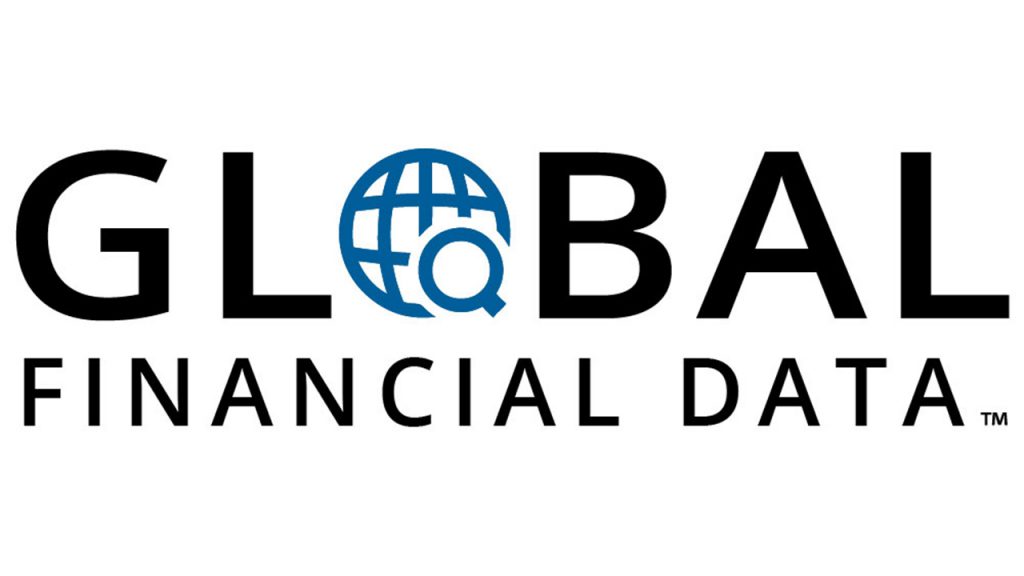 Global Financial Data is launching its own proprietary indices to help its customers analyze the trends in global stock markets that have occurred over the past 300 years.
Global Financial Data has the most extensive historical database of data on individual securities available anywhere. Data on individual securities from the United States begins in 1786 and includes information on over 75,000 securities. Data from the United Kingdom begins in 1690 and includes information on over 19,000 securities.
Global Financial Data is launching its own proprietary indices to help its customers analyze the trends in global stock markets that have occurred over the past 300 years.
Global Financial Data has the most extensive historical database of data on individual securities available anywhere. Data on individual securities from the United States begins in 1786 and includes information on over 75,000 securities. Data from the United Kingdom begins in 1690 and includes information on over 19,000 securities.
 Global Financial Data has added new data for GDP, including measures for Global GDP, regional GDP and data on several countries not previously covered. GFD has also added data on the Purchasing Managers’ Index for 50 countries.
GFD users now have access to a global measure of GDP, both in real and nominal terms, which they can use as a benchmark against the GDP other countries and regions. The nominal World GDP file (GDPWLD) goes back to 1960 and the Real World GDP file (GDPCWLD) goes back to 1950. Both files have 20 years of quarterly data.
Global Financial Data has added new data for GDP, including measures for Global GDP, regional GDP and data on several countries not previously covered. GFD has also added data on the Purchasing Managers’ Index for 50 countries.
GFD users now have access to a global measure of GDP, both in real and nominal terms, which they can use as a benchmark against the GDP other countries and regions. The nominal World GDP file (GDPWLD) goes back to 1960 and the Real World GDP file (GDPCWLD) goes back to 1950. Both files have 20 years of quarterly data.
 After five years of painstaking research, Global Financial Data is proud to announce that its database of thousands of over-the-counter (OTC) stocks has been completed and is now available to subscribers to the United States Stocks Database.
The US Stocks Database already provides data from all the nation’s stock exchanges, including the New York Stock Exchange from its inception in 1792, the AMEX/Curb since 1918, as well as Boston, Philadelphia, Chicago and other regional exchanges. The addition of the OTC data has completed Global Financial Data’s efforts to provide a complete view of the corporate history of the United States over the past 225 years.
After five years of painstaking research, Global Financial Data is proud to announce that its database of thousands of over-the-counter (OTC) stocks has been completed and is now available to subscribers to the United States Stocks Database.
The US Stocks Database already provides data from all the nation’s stock exchanges, including the New York Stock Exchange from its inception in 1792, the AMEX/Curb since 1918, as well as Boston, Philadelphia, Chicago and other regional exchanges. The addition of the OTC data has completed Global Financial Data’s efforts to provide a complete view of the corporate history of the United States over the past 225 years.
 The first attempt at a stock corner in the United States came at the birth of the American stock market, occurring even before the New York Stock Exchange had been established. Instead, it occurred in trading at Philadelphia. In 1792, Philadelphia was both the capitol and the financial center of the United States. Consequently, it is not surprising that politics and finance intermixed to create the nation’s first financial panic and the first time the government stepped in to save the markets from themselves.
The first attempt at a stock corner in the United States came at the birth of the American stock market, occurring even before the New York Stock Exchange had been established. Instead, it occurred in trading at Philadelphia. In 1792, Philadelphia was both the capitol and the financial center of the United States. Consequently, it is not surprising that politics and finance intermixed to create the nation’s first financial panic and the first time the government stepped in to save the markets from themselves.
Alexander Hamilton and the Bank of the United States
The Bank Scrip Bubble
Scrip on the Bank of the United States, which represented rights to buy full shares of stock, initially sold for $25 on July 1, 1791. To complete ownership, payments of $75 were due on December 31, 1791, $100 on July 1, 1791, $100 on December 31, 1792 and $100 on July 1, 1793. One-quarter of the payment had to be in gold, but the remaining three-quarters could be made in U.S. government bonds. By allowing three-fourths of the payment to be made in United States debt securities, the prices of U.S. government bonds immediately rose in price. U.S. government debt had been reorganized in October 1790 into the Sixes and Threes, at which point the Sixes traded at 70, and by July 31, 1791, the Sixes were trading at 100. Since Hamilton had taken over as Secretary of the Treasury, U.S. government bonds had risen in price from 25 back to par at 100. Fully-paid shares in the Bank of the United States were issued in August 1791, and they rose in price from 530 to 740 by the end of August, only to fall back to 524 by early October. Trading also occurred in the scrip of the Bank of the United States, which represented shares that had not been fully paid for (these later became half shares and three-quarter shares as payments became due). The scrip went on an even wilder ride, rising from 25 at the beginning of August to 249 on August 12, 1791, falling to 165, rising again to 207 on August 22, then sliding back to 121 by September 16. The speculation became known as the Bank Scrip Bubble of 1791. Within weeks of the issuance of Bank shares, the nation had gone through its first stock market bubble and crash.
The charter creating the Bank of the United States had set up the Sinking Fund Commission composed of Vice President John Adams, Secretary of State Thomas Jefferson, Attorney General Edmund Randolph, Chief Justice John Jay, and Secretary of the Treasury Alexander Hamilton, charged with resolving financial crises. The Bank Scrip Bubble provided the Commission their first test.
Hamilton met with fellow members of the Treasury’s Sinking Fund Commission and persuaded them to authorize purchases of government securities in the market place to keep the prices of stocks and bonds from collapsing. Hamilton worked with William Seton, the cashier of the Bank of New York, to authorize the purchase of $150,000 of public debt in New York to be covered by government revenues. By September 12, Hamilton’s intervention had not only stabilized the market, but had also laid the groundwork for his cooperation with the Bank of New York, which would later be crucial in ending the Panic of 1792.
Duer and the “Six Percent Club”
The Society for Establishing Useful Manufactures (SUM) was established in 1791 to promote industrial development along the Passaic River in New Jersey, founding the city of Patterson in the process. The goal was to use the Great Falls of the Passaic River as a power source for grist mills. The company was the idea of Assistant Secretary of the Treasury Tench Coxe, and was charted in New Jersey under Hamilton’s direction as a type of public-private partnership. Hamilton asked William Duer, who had sided with Hamilton in The Federalist Papers, writing in support of the United States Constitution under the alias of “Philo-Publius,” to become governor and chief salesmen for the SUM. Duer was instrumental in helping to raise $500,000 in capital for the new company. William Duer was not only a master salesman, but a speculator as well. When Hamilton discovered that Duer had been a driving force in the “scripomania” which had driven the Bank Scrip Bubble, he sent Duer a letter admonishing him for speculating in bank scrip. Like any plunger, his failure in the Bank Scipr Bubble only motivated him to invest on a larger scale and to try and have greater control over the market to insure success. Duer organized a pool along with Alexander Macomb, a wealthy land speculator who had purchased the largest piece of property from the state of New York, and with other owners of shares in the Bank of the United States. They were known as “The Six Percent Club” since shares in the Bank of the United States paid a 6% dividend. Their goal was to try and corner the market before the next distribution of shares in July 1792 and sell the shares to European investors at a profit. Duer and the others bought the shares on time, in essence buying options, rather than buying full shares, so they could maximize their profit through leverage. The Bank of the United States finally opened in December 1791, and made use of its capital by making loans and issuing banknotes. This increased the money supply and helped to feed new speculation in bank shares and U.S. 6% bonds. The wild ride in shares of the Bank of the United States continued. Shares rose in price from 524 to 680 on October 26, 1792, fell back to 528 on December 17, 1791 and rose to 712 on January 4, 1792. Since the U.S. Government Sixes could be used to buy shares, their price rose in sympathy with the increase in the price of the Bank of the United States, rising to 129 on March 5, 1792.
Duer got others to invest with him, reportedly including a madam from one of the city’s brothels, who probably kept the money hidden in one of the well-worn beds, and cosigned notes with merchants to raise capital. Duer even withdrew $292,000 from the treasury of the SUM for personal investments and expenses to allow him to buy even more shares, an act that would later lead to his downfall.
With the shares overvalued, a number of shorts formed a bear raid to push the stock price lower. The bears were led by Governor George Clinton of New York, an ally of Thomas Jefferson who was opposed to the Bank of the United States and to Alexander Hamilton. Anything Clinton could do to embarrass the bank or cause it to fail would help Jefferson and his cause. Clinton and his clique sold short all the stock they could to Duer.


